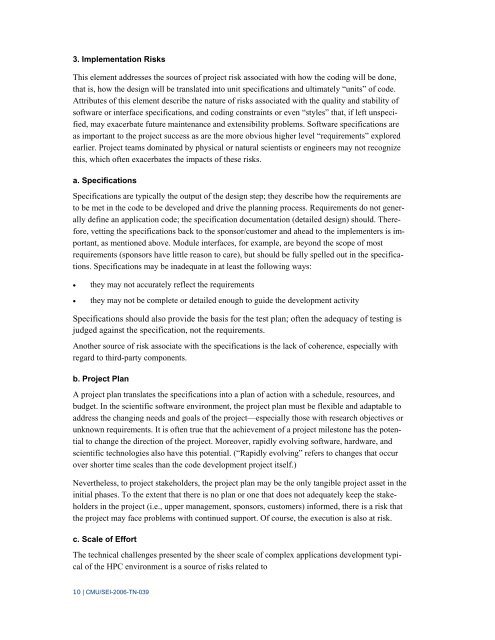A Proposed Taxonomy for Software Development Risks for High ...
A Proposed Taxonomy for Software Development Risks for High ...
A Proposed Taxonomy for Software Development Risks for High ...
Create successful ePaper yourself
Turn your PDF publications into a flip-book with our unique Google optimized e-Paper software.
3. Implementation <strong>Risks</strong><br />
This element addresses the sources of project risk associated with how the coding will be done,<br />
that is, how the design will be translated into unit specifications and ultimately “units” of code.<br />
Attributes of this element describe the nature of risks associated with the quality and stability of<br />
software or interface specifications, and coding constraints or even “styles” that, if left unspecified,<br />
may exacerbate future maintenance and extensibility problems. <strong>Software</strong> specifications are<br />
as important to the project success as are the more obvious higher level “requirements” explored<br />
earlier. Project teams dominated by physical or natural scientists or engineers may not recognize<br />
this, which often exacerbates the impacts of these risks.<br />
a. Specifications<br />
Specifications are typically the output of the design step; they describe how the requirements are<br />
to be met in the code to be developed and drive the planning process. Requirements do not generally<br />
define an application code; the specification documentation (detailed design) should. There<strong>for</strong>e,<br />
vetting the specifications back to the sponsor/customer and ahead to the implementers is important,<br />
as mentioned above. Module interfaces, <strong>for</strong> example, are beyond the scope of most<br />
requirements (sponsors have little reason to care), but should be fully spelled out in the specifications.<br />
Specifications may be inadequate in at least the following ways:<br />
• they may not accurately reflect the requirements<br />
• they may not be complete or detailed enough to guide the development activity<br />
Specifications should also provide the basis <strong>for</strong> the test plan; often the adequacy of testing is<br />
judged against the specification, not the requirements.<br />
Another source of risk associate with the specifications is the lack of coherence, especially with<br />
regard to third-party components.<br />
b. Project Plan<br />
A project plan translates the specifications into a plan of action with a schedule, resources, and<br />
budget. In the scientific software environment, the project plan must be flexible and adaptable to<br />
address the changing needs and goals of the project—especially those with research objectives or<br />
unknown requirements. It is often true that the achievement of a project milestone has the potential<br />
to change the direction of the project. Moreover, rapidly evolving software, hardware, and<br />
scientific technologies also have this potential. (“Rapidly evolving” refers to changes that occur<br />
over shorter time scales than the code development project itself.)<br />
Nevertheless, to project stakeholders, the project plan may be the only tangible project asset in the<br />
initial phases. To the extent that there is no plan or one that does not adequately keep the stakeholders<br />
in the project (i.e., upper management, sponsors, customers) in<strong>for</strong>med, there is a risk that<br />
the project may face problems with continued support. Of course, the execution is also at risk.<br />
c. Scale of Ef<strong>for</strong>t<br />
The technical challenges presented by the sheer scale of complex applications development typical<br />
of the HPC environment is a source of risks related to<br />
10 | CMU/SEI-2006-TN-039
















